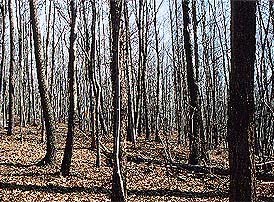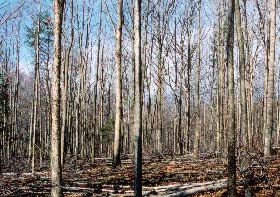 |
 |
 |
 |
 |
 |
 |
 |
 |
 |
 |
 |

Fred Scott,
Jr.
(434) 295-4188 |
|
|

Heavy hardwood timber makes for lovely walks and horseback rides on trails through the timber. So how does one grow such a forest?
One way is to begin with native pine woodlands, and lots of bluejays and squirrels. The jays will pick up an acorn in the open hardwood forest, then take it into the pines (where the sharpshin hawk cannot eat the bluejay). The jay will drop a few and the sun-loving acorn will grow in the sunny pine floor.
 Shown here on the left, a pine forest that was clearcut to the ground fifteen years prior to this photo. Note the far-too-extensive regrowth of undesirable maples, scarlet oaks, and too-dense hickory and chesnut oaks, with a few desirable white oaks and northern red oaks. While some of the species selection comes from the site being dry and south facing, thereby favoring the scarlet and chesnut oaks, every tree is a hardwood. Shown here on the left, a pine forest that was clearcut to the ground fifteen years prior to this photo. Note the far-too-extensive regrowth of undesirable maples, scarlet oaks, and too-dense hickory and chesnut oaks, with a few desirable white oaks and northern red oaks. While some of the species selection comes from the site being dry and south facing, thereby favoring the scarlet and chesnut oaks, every tree is a hardwood.
Did we say sunny under pines? Hard to believe, is it not? The pine forest floor is more sunny than under a heavy oak canopy, where it's often too shady for acorns to make it beyond a year or two. Just ask Tom Dierauf, a retired Virginia State Forester. Tom did forest research for thirty years. His research, on thousands of forest plots on a wide variety of subjects, shows that...
|
... in pre-colonial days a wildfire would come along and wipe out - or burn back - the shade-tolerant (generally undesirable) saplings. Today we have clearcuts of pine that have nearly the same effect, as do pine bark beetle infestations , and major hurricanes or ice storms. The one- or two-inch diameter oak saplings can often survive the devastation and they will thrive and win the contest in the race for the sky. Surprising as it may seem... today, in the absence of native wildfire, this method is our best hope for creating oak stands!
Tom Dierauf's research  shows that - since we have mostly eliminated natural wildfire - our Appalachian hardwood forests are changing from oaks and tulip poplars to less-desirable shade-tolerant species like the soft maples; so we have begun using a recommended practice called Timber Stand Improvement, shown to the right, which emulates natural wildfire. shows that - since we have mostly eliminated natural wildfire - our Appalachian hardwood forests are changing from oaks and tulip poplars to less-desirable shade-tolerant species like the soft maples; so we have begun using a recommended practice called Timber Stand Improvement, shown to the right, which emulates natural wildfire.
Our forester marked every undesirable tree, then our wood crew cut them all down, leaving the cuttings to rot and provide shelter for nesting wild turkeys. The resprouting stumps provide browse for our Virginia whitetail deer, birds, and other wildlife, and may become a valuable source of timber regeneration in the future..
It now looks like a big garden that has just been weeded! Just wonderful.
|
|
|






